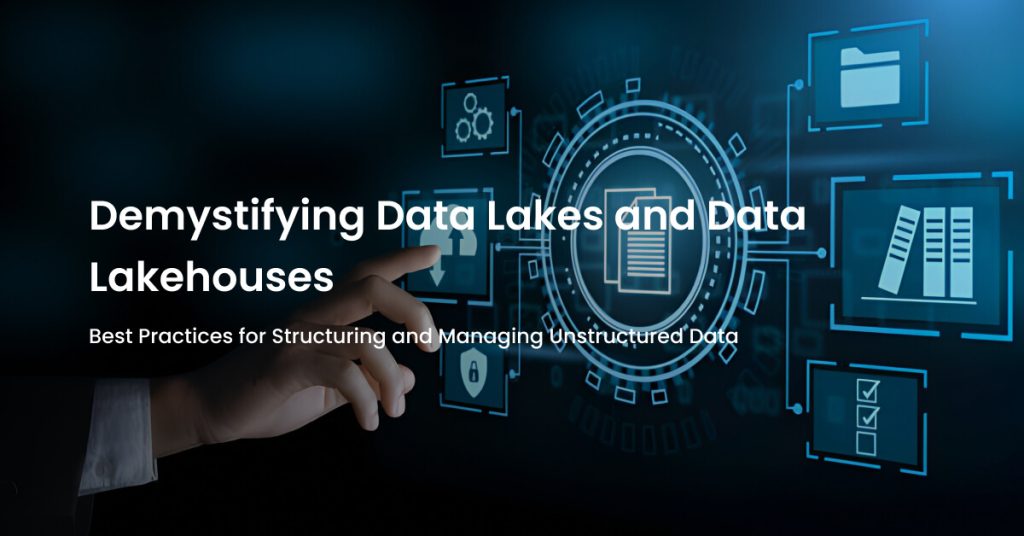
A survey by Statista projects data (unstructured) growth will be more than 180 zettabytes by 2025, indicating businesses need to tap on the potential of unstructured data in detail to drive insights that can bring a competitive advantage in the rapid business environment. The statistics also indirectly convey the need for a data management solution as organizations stumble over the 3 V’s of data, volume, velocity and variety for data access and integration. The overlook on unstructured data is high due to the absence of a storage repository that can account for data on a daily basis. If this reason stays true, then organizations lack the ability to implement advanced analytics and data modeling because data left unattended for a longer period of time loses its value, leading to a stagnant and risk prone environment.
Imagine if your peers made a point to utilize every piece of data received from diverse sources. Curious to know what they will achieve?
 Prior customer understanding
Prior customer understanding Strategic decision making
Strategic decision making Improved partnerships
Improved partnerships New innovations
New innovations Mitigate risks and fraud
Mitigate risks and fraud
Thus, clearly emphasizing the need for a data lake architecture and a data lakehouse, a hybrid model storage repository for organizations to meet modern business. This blog is a read on data lakes and data lakehouses, their architecture and the significance of managing unstructured data. The blog also underscores the difference between the three data storage solutions—a data warehouse, a data lake and a data lakehouse—for a comprehensive understanding of business reliance on a data lakehouse.
Data Lake: An Overview
As stated earlier, a data lake is a virtual repository to store data from various business applications and non-relational data sources. Unlike data warehouses, the data lake imbibes a flat architecture and object storage that does not demand the structure of data to be established upfront, assisting in storing data in its raw and native format. This object storage helps in providing metadata and unique identifiers for the data, empowering easy retrieval of data and performance. Also, if your organization is aiming to gain deep insights through machine learning and advanced analytics techniques, then a data lake can be the right choice, where data is stored and then made available to the research team.
Data Lake Architecture
The data lake architecture is one of the reasons for its popularity. A quick examination of it will help us understand how data lakes assist in managing unstructured data for better decision making.
Data sources, data ingestion, data storage, and data consumption are the primary layers of the data lake architecture. While each layer has its own responsibilities to perform, the overall architecture of a data lake is to support the storage of raw data and enable advanced analytics and machine learning on the unstructured data, which is crucial for modern businesses.
Data Source: The beginning of data in the lake is segregated into three buckets, one for structured data, one for semi-structured data and the last bucket for unstructured data. This underscores the data lake’s ability to source data from diverse areas, like a sensor, where the data is completely raw and real in the form of an image or video or from a relational database, like a Microsoft SQL Server, where the data is completely refined and defined.
Data Ingestion: Once the data is sourced, its time for it to enter the data lake either in batch or real-time ingestion mode. For example, data from log files and data backups can be accessed once a week or a day. In contrast, time-sensitive data from fraud detection or error identification needs to be ingested in real-time.
Data Storage: The data ingested or transmitted from the source gets stored in batches and in real-time. Here, the data undergoes three layers before it gets processed for analytics.
- Raw Space: The data is kept untouched, meaning it is in its raw format, with the help of data storage solutions like Microsoft Azure Blob storage.
- Transformation Space: The residing data is made to undergo data cleansing, data enrichment, data formatting and data structuring. This stage is where data is shaped into a form that is labeled as trusted data.
- Processing Space: Being a crucial layer for data, the processing section ensures the data are well integrated, effectively moulding them for actionable insights and decision making.
Data Consumption:The final stage in the data lake is reached, where the data is made available to end-users via business intelligence tools like Microsoft Power BI to empower data analysts, executives and other data scientists to drive insights that help their businesses grow and expand.
Thus, an overview of the data lake architecture clearly explains how the integration of data from diverse sources gets converted into reliable data that has no compromise on its integrity or business value. However, the data lake has certain limitations in regards to metadata management, adherence to compliance regulations, and difficulty processing heavy volumes of data due to the traditional query engine.
Data Lakehouse: An Explanatory Section
To meet the challenges of modern businesses and innovate solutions based on data insights, it is essential to have an architecture that assists in a better data management solution. Data Lakehouse, being a combination of the best from the data warehouse and data lake, seems to fit the modern business model so well, assisting data scientists and analysts with a flexible and cost-effective data storage solution.
Let’s take a look at the features of Data Lakehouse that make it a standout solution among the three data storage solutions.
ACID Transaction Support: To maintain data integrity, data lakehouse support through ACID transactions plays a major role in confirming the authenticity of the data, irrespective of numerous reads and writes.
- A stands for atomicity, meaning the transaction is conducted as a single, indivisible unit of work.
- C stands for consistency, ensuring the data remains reliable and adheres to rules and regulations before and after the transactions.
- I stands for isolation, indicating the process takes place in a serialized manner, reducing issues such as dirty reads, non-repeatable reads, and phantom reads.
- D stands for durability, guaranteeing the changes made are not lost in the course of a failure attack.
Schema Enforcement: Known as the mix of data warehouse and data lake, the data lakehouse ingests the schema-on reads that insist on the specification of data format, including rules, constraints and data types. Thus, empowering organizations to ingest data into the predefined schema makes sure only consistent and reliable data is uploaded.
Open Format: Designed to be interoperable, data lakehouse file formats are open, indicating the accessibility and readability of diverse tools, making them ideal for sharing across systems and applications. To support both data warehouse and data lake formats, Data Lakehouse utilizes file formats like Apache Parquet and ORC to store data efficiently and for future-proofing in their data management and analytics initiatives.
A Brief on Data Lakehouse Architecture
Let’s get into the data lakehouse architecture, which comprises five layers
Ingestion Layer:
The layer is in charge of gathering data and transforming it into a file format that the data lakehouse architecture can store and analyze. By utilizing protocols like JDBC/ODBC, REST APIs or MQTT, the data lakehouse gets data from external and internal sources that include database management systems like MySQL and Oracle, social media like Twitter and LinkedIn, and streaming platforms like Striim.
Storage Layer:
The layer is responsible for storing data of all kinds, like raw, structured or semi-structured. To support this, the storage layer ensures the data is stored in an open file format like Parquet or ORC. This attribute of the data lakehouse’s ability to accommodate diverse data at a low cost makes it more accessible and interoperable.
Metadata Layer:
The layer serves as the index for the data set stored in the database by providing metadata for every piece of data in the object storage. This includes details of the data, like structure, format, ownership and lineage. Also, within the metadata layer, users can use predefined schemas that ensure data is structured, documented and governed. Thus, a metadata layer helps organizations with the better usage of data and management.
API Layer:
The layer is designed to facilitate task processing and advanced analytics on the stored data. The layer also helps developers and users engage with the data pipeline in the preferred programming language, indicating data lakehouse potential in supporting Python, Scala or Java, along with libraries such as TensorFlow, PyTorch, Scikit-Learn, and Spark MLlib, to build and deploy machine learning models and analytical applications, thus empowering organizations to utilize the full potential of data lakehouse.
Data Consumption Layer:
The final layer of the data lakehouse architecture serves as a platform for users to derive insights from the dataset by performing advanced analytics, data visualization, business intelligence, and machine learning. Thus, the layer acts as a unified interface for users to access the data for effective exploration, discovery and interpretation of business decisions.
Best Practices for Managing Unstructured Data
With a comprehensive understanding of Data Lake and Data Lakehouse, it is important to implement a few best practices that help with structuring and managing unstructured data. The analysis of the data lake and data lakehouse will help to formulate the practices that can help organizations organize unstructured data in a way that does not pose any governance concern or compromise on data integrity and security.
Define Data Governance Policies:
- The foremost step in managing unstructured data is to set rules, standards and procedures by defining the ownership of the data. This will help in identifying the team responsible for the data throughout its lifecycle.
- Setting boundaries for the dataset by implementing access controls, authorization policies, and authentication mechanisms helps secure unstructured data from unwanted access and data loss.
- Defining the retention period for the data is also important, for it helps in understanding the lifecycle of the data. Also, the retention period gives organizations the ability to set resource allocation, look to legal requirements and follow other processes for the data during its retention period.
Implement Metadata Management:
- Establishing attributes like data source, format, owner, and other information helps define the unstructured data objects.
- This metadata, once captured, is stored in a centralized repository that serves as the inventory to access and explore the data stored in the data lake and data lakehouses.
Landing Zone for Raw Data:
- It is important to have an initial storage space for unstructured data before it is subject to data cleansing and verification.
- The data lake landing zone serves this purpose, where the data ingested from various sources of different formats and structures is kept here in its native format, making sure the data does not lose its inherent value and other insights.
Apply Data Lakehouse Principles:
- As stated earlier, one of the most important aspects of Data Lakehouse is its ability to have open file formats for data like Parquet or ORC.
- These file formats are optimized for efficient storage, compression, and query performance, making them well-suited for storing large volumes of unstructured data in a cost-effective and scalable manner.
Enable Data Lineage and Auditing:
- The ability to trace data usage is essential to tracking the lineage of unstructured data. From knowing who the authorized personnel are to what kind of data cleaning and enrichment details are added to what it generates, every detail is important to assess its authenticity and integrity.
- It also facilitates data quality management by identifying potential sources of data errors or inconsistencies and enabling organizations to trace and remediate data quality issues effectively.
Overall, data lake and data lakehouse architecture ensures that no data is eliminated or compromised on quality. This also helps organizations not to let go of unstructured data but instead, tap on its potential and scale business operations to new heights.
For a quick glance at why data lakehouse is the most reliant virtual storage solution, a summary of each aspect of data warehouse, data lake and data lakehouse is provided below. Make sure your organization makes the best choice.
Particulars | Data Warehouse | Data Lake | Data Lakehouse |
|---|---|---|---|
Data type | Only structured data type. | Both structured, semi-structured and unstructured data types. | Both structured, semi-structured and unstructured data types. |
Schema | Schema-on-write. | Schema-on-read. | Schema-on-read. |
Storage | Traditional relational database or proprietary warehouse | Distributed data storage or cloud storage. | Distributed data storage or cloud storage. |
Processing | Batch processing, ideal for structured queries and reporting | Batch processing and real-time. | Batch processing and real-time. |
Data integration | Traditional Extract Transform Load (ETL) process. | ETL process; data transformation deferred until needed. | ETL processes and supports real-time transformations. |
Use cases | Business Intelligence, reporting, and structured analysis | Data exploration, Big Data analysis and Machine Learning | Hybrid analytics, unified analytics and real-time analytics. |
Wrapping Up
To conclude, saving data is as essential as driving insights from it. But at what cost is the real question? Utilizing virtual storage solutions like data warehouses, data lake and data lakehouse has been in practice for a long time, but the need to look into them from the perspective of business needs is imperative. Tapping into the potential of the data pipeline will help your business gain a competitive edge. Also, the language models are trained in such a way to analyze the unstructured data and gain insights. So, what is your strategy to manage and structure this data?
Get on a call with experts at SquareOne Technologies, who have been in the industry for more than a decade, assisting companies like yours with big data management solutions. Pave your business the path to success with SquareOne Technologies today!

















